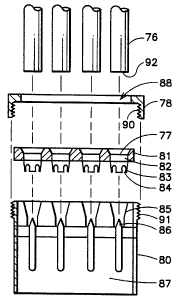Some of the information on this Web page has been provided by external sources. The Government of Canada is not responsible for the accuracy, reliability or currency of the information supplied by external sources. Users wishing to rely upon this information should consult directly with the source of the information. Content provided by external sources is not subject to official languages, privacy and accessibility requirements.
Any discrepancies in the text and image of the Claims and Abstract are due to differing posting times. Text of the Claims and Abstract are posted:
| (12) Patent: | (11) CA 2314145 |
|---|---|
| (54) English Title: | ELECTRICAL CONNECTOR |
| (54) French Title: | CONNECTEUR ELECTRIQUE |
| Status: | Deemed expired |
| (51) International Patent Classification (IPC): |
|
|---|---|
| (72) Inventors : |
|
| (73) Owners : |
|
| (71) Applicants : |
|
| (74) Agent: | PERRY + CURRIER |
| (74) Associate agent: | |
| (45) Issued: | 2005-12-20 |
| (86) PCT Filing Date: | 1998-06-11 |
| (87) Open to Public Inspection: | 1999-07-08 |
| Examination requested: | 2003-06-06 |
| Availability of licence: | N/A |
| (25) Language of filing: | English |
| Patent Cooperation Treaty (PCT): | Yes |
|---|---|
| (86) PCT Filing Number: | PCT/US1998/012136 |
| (87) International Publication Number: | WO1999/034483 |
| (85) National Entry: | 2000-06-12 |
| (30) Application Priority Data: | ||||||
|---|---|---|---|---|---|---|
|
An electrical connector (10) for
coupling to a plurality of insulated electrical
conductors (28, 30) has a housing (11) and
a housing cover both having a plurality of
bores therein, at least a portion of each
bore being tapered. A plurality of
electrical conductive prongs each having one end
attached to the housing and extending
axially into each housing bore for receiving
the end of an insulated electrical conductor.
Attaching means attach the housing cover
to the housing over a plurality of
compression collars. Each compression collar has
a bore extending axially therethrough to
allow for insertion of a wire therethrough and
into the housing bore and onto a pointed
prong.
La présente invention concerne un connecteur électrique (10) destiné à coupler plusieurs conducteurs électriques isolés (28,30). Ledit connecteur électrique comprend un boîtier (11) et un couvercle de boîtier traversés chacun par plusieurs alésages possédant chacun au moins une partie conique. Plusieurs broches électroconductrices possédant chacune une extrémité fixée au boîtier s'étendent axialement jusque dans chaque alésage de boîtier afin de recevoir l'extrémité d'un conducteur électrique isolé. Des moyens de fixation permettent de fixer le couvercle de boîtier sur le boîtier, au-dessus de plusieurs colliers de serrage. Chaque collier de serrage est traversé par un alésage axial qui permet l'insertion d'un fil jusque dans l'alésage de boîtier, et sur une broche pointée.
Note: Claims are shown in the official language in which they were submitted.
Note: Descriptions are shown in the official language in which they were submitted.

For a clearer understanding of the status of the application/patent presented on this page, the site Disclaimer , as well as the definitions for Patent , Administrative Status , Maintenance Fee and Payment History should be consulted.
| Title | Date |
|---|---|
| Forecasted Issue Date | 2005-12-20 |
| (86) PCT Filing Date | 1998-06-11 |
| (87) PCT Publication Date | 1999-07-08 |
| (85) National Entry | 2000-06-12 |
| Examination Requested | 2003-06-06 |
| (45) Issued | 2005-12-20 |
| Deemed Expired | 2014-06-11 |
There is no abandonment history.
| Fee Type | Anniversary Year | Due Date | Amount Paid | Paid Date |
|---|---|---|---|---|
| Registration of a document - section 124 | $100.00 | 2000-06-12 | ||
| Application Fee | $150.00 | 2000-06-12 | ||
| Maintenance Fee - Application - New Act | 2 | 2000-06-12 | $50.00 | 2000-06-12 |
| Maintenance Fee - Application - New Act | 3 | 2001-06-11 | $50.00 | 2001-05-30 |
| Maintenance Fee - Application - New Act | 4 | 2002-06-11 | $100.00 | 2002-05-30 |
| Maintenance Fee - Application - New Act | 5 | 2003-06-11 | $150.00 | 2003-06-04 |
| Request for Examination | $400.00 | 2003-06-06 | ||
| Maintenance Fee - Application - New Act | 6 | 2004-06-11 | $200.00 | 2004-06-10 |
| Maintenance Fee - Application - New Act | 7 | 2005-06-13 | $200.00 | 2005-05-20 |
| Final Fee | $300.00 | 2005-10-05 | ||
| Maintenance Fee - Patent - New Act | 8 | 2006-06-12 | $200.00 | 2006-05-03 |
| Maintenance Fee - Patent - New Act | 9 | 2007-06-11 | $200.00 | 2007-06-08 |
| Maintenance Fee - Patent - New Act | 10 | 2008-06-11 | $450.00 | 2009-05-13 |
| Maintenance Fee - Patent - New Act | 11 | 2009-06-11 | $250.00 | 2009-05-13 |
| Maintenance Fee - Patent - New Act | 12 | 2010-06-11 | $250.00 | 2010-06-02 |
| Maintenance Fee - Patent - New Act | 13 | 2011-06-13 | $250.00 | 2011-06-08 |
| Maintenance Fee - Patent - New Act | 14 | 2012-06-11 | $250.00 | 2012-06-07 |
Note: Records showing the ownership history in alphabetical order.
| Current Owners on Record |
|---|
| CENTERPIN TECHNOLOGY, INC. |
| Past Owners on Record |
|---|
| MCCARTHY, DALE C. |